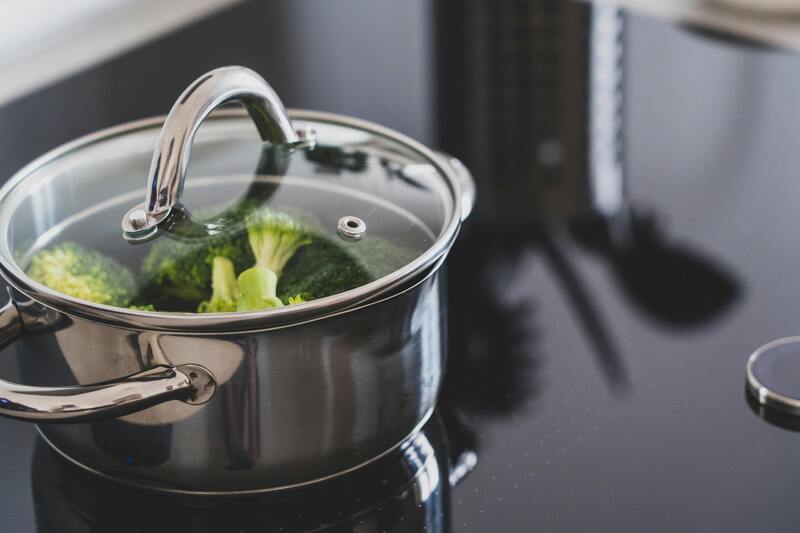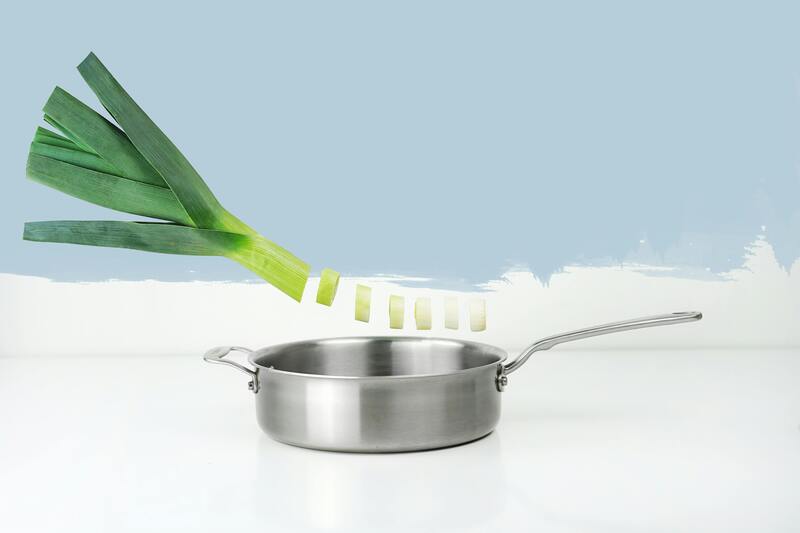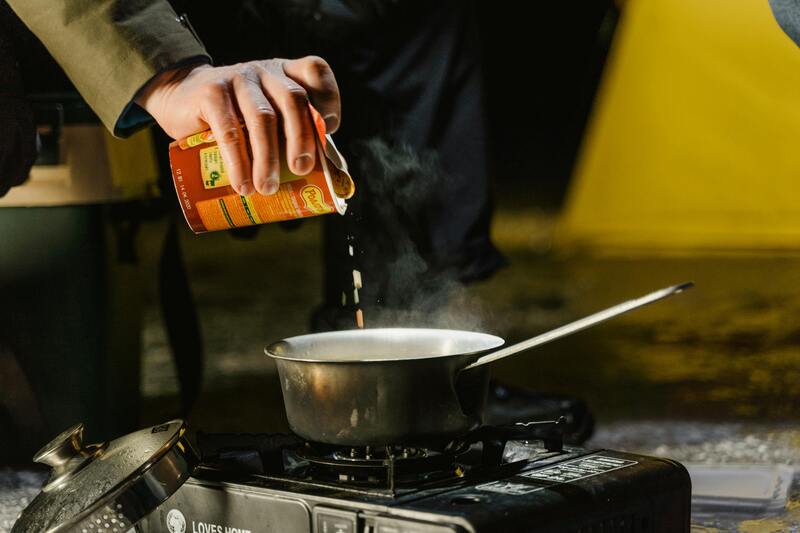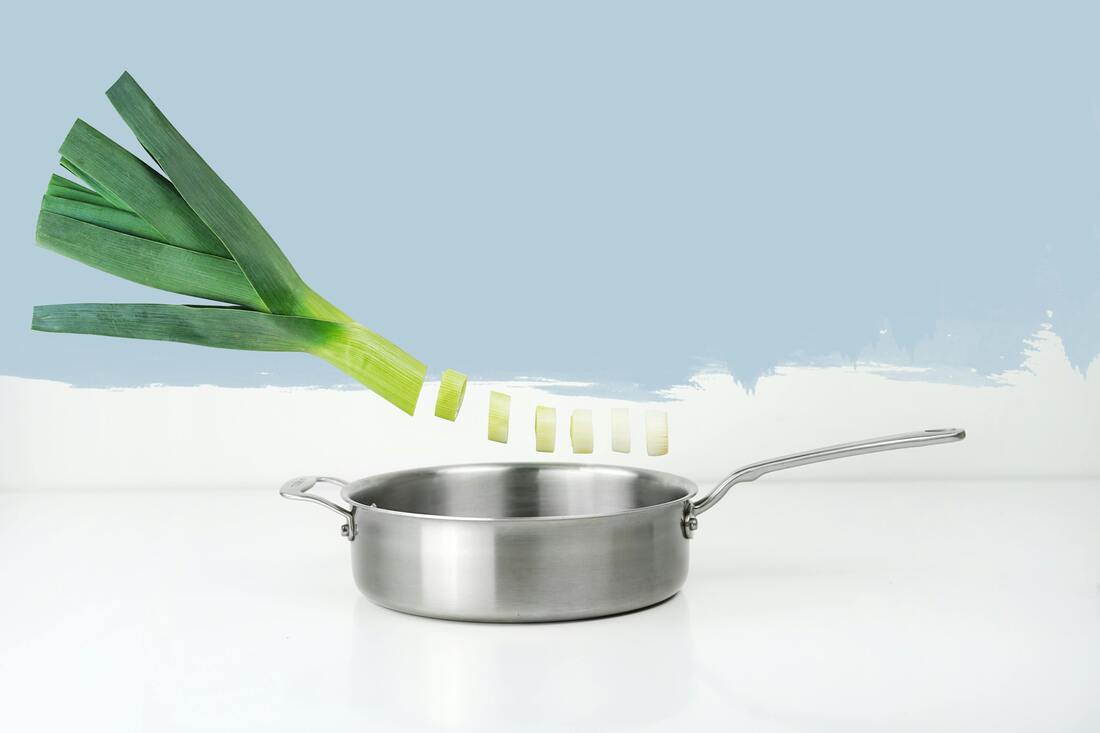1. Cooking Pots: A Quick Guide
Saucepan:
* What it is: A deep pot with a long handle.
* What it's for: Great for boiling stuff, making sauces, cooking grains, and soups.
* Quick tip: Best if you're not making a huge amount.
Stockpot:
* What it is: A really tall, big pot with two handles.
* What it's for: Making lots of soup, broth, stew, or boiling pasta.
* Quick tip: Perfect when you're cooking for a crowd.
Dutch Oven/Casserole Pot:
* What it is: A heavy pot with thick sides, often made of cast iron or ceramic, and it has a lid
* What it's for: It's good to cook at low temp cooking, braising(searing and cooking) , roasting things, or even baking bread.
* Quick tip: It keeps the heat even, good for recipes that take a while.
Frying Pan/Skillet:
* What it is: A wide, not so deep pot, usually with sides that slant out.
* What it's for: Searing meat, frying, and sautéing veggies.
* Quick tip: Get one that doesn't stick or one with steel for cooking different things.
Stock Pot with Steamer Insert:
* What it is: A stockpot that comes with a basket that fits inside.
* What it's for: Steaming veggies, seafood, or dumplings.
Pressure Cooker:
* What it is: A pot that seals tight with a valve on top.
* What it's for: Cooking food super fast, like beans, stews, and tougher meats.
* Quick tip: Cuts down cooking time a lot
Specialty Pots:
* Wok: For Asian-style cooking—stir-frying, deep frying, and steaming.
* Tagine: For North African dishes that cook for a long time. It has a cone-shaped lid.
* Milk Pot/Butter Warmer: A small, tall pot for heating stuff gently.
2. What Pots Are Made Of:
* Stainless Steel
* Pros: Lasts long, doesn't mess with the taste of food, and you can put it in the dishwasher.
* Cons: Doesn't spread heat that well on its own.
* Good for: Boiling, simmering, and cooking things with tomatoes or lemon juice.
* Aluminum
* Pros: Heats up fast and is light.
* Cons: Can react with acidic foods and bend out of shape.
* Good for: Cooking everyday meals, like sauteing.
* Copper
* Pros: Gives you great control over the heat.
* Cons: Costs a lot, needs to be polished, and can react with some foods.
* Good for: Cooking fancy sauces where you need to be precise.
* Cast Iron
* Pros: Holds heat really well, making it good for cooking at a low temp for a while.
* Cons: It's heavy and you need to season it so food doesn't stick.
* Good for: Stews, frying stuff, and baking.
* Nonstick
* Pros: Easy to clean and you don't need much fat to cook.
* Cons: Can get scratched easily and can't handle high heat.
* Good for: Eggs, pancakes, and foods that stick easily.
* Ceramic/Enameled
* Pros: Doesn't react with food and looks nice.
* Cons: Heavy and can chip.
* Good for: Cooking slow and making soups or stews.
3. Lid Types:
* Tight-fitting lids: Keep moisture and heat in—good for simmering.
* Glass lids: So you can see what's cooking without lifting the lid.
* Vented lids: Let steam out so the pot doesn't boil over.
4. Cooking Stuff:
* Boiling: Use a big pot with lots of water.
* Simmering: Use a pot with a thick bottom so the food doesn't burn.
* Braising: Use a Dutch oven to hold the heat evenly.
* Sautéing/Frying: Use a wide pan with short sides to stir easily.
* Steaming: Use a pot with a steamer basket.
5. Taking Care of Your Pots:
* Stainless Steel: Don't use steel wool; polish with vinegar to make it shine.
* Cast Iron: Rub with oil and dry it right away
* Nonstick: Use soft stuff to stir and wash by hand.
* Aluminum/Copper: Don't cook acidic foods in aluminum; polish copper sometimes.
* Storage: Stack them carefully with cloths in between to keep them from getting scratched.
6. Get Good at Pot Cooking:
* Warm up heavy pots before adding food so it doesn't stick.
* Use a pot that's the same size as your burner for even cooking.
* Keep the lid on to save heat and time.
* Use soft utensils when stirring nonstick pots.
* Don't change the temp too fast with glass or ceramic pots, or they might break.
Saucepan:
* What it is: A deep pot with a long handle.
* What it's for: Great for boiling stuff, making sauces, cooking grains, and soups.
* Quick tip: Best if you're not making a huge amount.
Stockpot:
* What it is: A really tall, big pot with two handles.
* What it's for: Making lots of soup, broth, stew, or boiling pasta.
* Quick tip: Perfect when you're cooking for a crowd.
Dutch Oven/Casserole Pot:
* What it is: A heavy pot with thick sides, often made of cast iron or ceramic, and it has a lid
* What it's for: It's good to cook at low temp cooking, braising(searing and cooking) , roasting things, or even baking bread.
* Quick tip: It keeps the heat even, good for recipes that take a while.
Frying Pan/Skillet:
* What it is: A wide, not so deep pot, usually with sides that slant out.
* What it's for: Searing meat, frying, and sautéing veggies.
* Quick tip: Get one that doesn't stick or one with steel for cooking different things.
Stock Pot with Steamer Insert:
* What it is: A stockpot that comes with a basket that fits inside.
* What it's for: Steaming veggies, seafood, or dumplings.
Pressure Cooker:
* What it is: A pot that seals tight with a valve on top.
* What it's for: Cooking food super fast, like beans, stews, and tougher meats.
* Quick tip: Cuts down cooking time a lot
Specialty Pots:
* Wok: For Asian-style cooking—stir-frying, deep frying, and steaming.
* Tagine: For North African dishes that cook for a long time. It has a cone-shaped lid.
* Milk Pot/Butter Warmer: A small, tall pot for heating stuff gently.
2. What Pots Are Made Of:
* Stainless Steel
* Pros: Lasts long, doesn't mess with the taste of food, and you can put it in the dishwasher.
* Cons: Doesn't spread heat that well on its own.
* Good for: Boiling, simmering, and cooking things with tomatoes or lemon juice.
* Aluminum
* Pros: Heats up fast and is light.
* Cons: Can react with acidic foods and bend out of shape.
* Good for: Cooking everyday meals, like sauteing.
* Copper
* Pros: Gives you great control over the heat.
* Cons: Costs a lot, needs to be polished, and can react with some foods.
* Good for: Cooking fancy sauces where you need to be precise.
* Cast Iron
* Pros: Holds heat really well, making it good for cooking at a low temp for a while.
* Cons: It's heavy and you need to season it so food doesn't stick.
* Good for: Stews, frying stuff, and baking.
* Nonstick
* Pros: Easy to clean and you don't need much fat to cook.
* Cons: Can get scratched easily and can't handle high heat.
* Good for: Eggs, pancakes, and foods that stick easily.
* Ceramic/Enameled
* Pros: Doesn't react with food and looks nice.
* Cons: Heavy and can chip.
* Good for: Cooking slow and making soups or stews.
3. Lid Types:
* Tight-fitting lids: Keep moisture and heat in—good for simmering.
* Glass lids: So you can see what's cooking without lifting the lid.
* Vented lids: Let steam out so the pot doesn't boil over.
4. Cooking Stuff:
* Boiling: Use a big pot with lots of water.
* Simmering: Use a pot with a thick bottom so the food doesn't burn.
* Braising: Use a Dutch oven to hold the heat evenly.
* Sautéing/Frying: Use a wide pan with short sides to stir easily.
* Steaming: Use a pot with a steamer basket.
5. Taking Care of Your Pots:
* Stainless Steel: Don't use steel wool; polish with vinegar to make it shine.
* Cast Iron: Rub with oil and dry it right away
* Nonstick: Use soft stuff to stir and wash by hand.
* Aluminum/Copper: Don't cook acidic foods in aluminum; polish copper sometimes.
* Storage: Stack them carefully with cloths in between to keep them from getting scratched.
6. Get Good at Pot Cooking:
* Warm up heavy pots before adding food so it doesn't stick.
* Use a pot that's the same size as your burner for even cooking.
* Keep the lid on to save heat and time.
* Use soft utensils when stirring nonstick pots.
* Don't change the temp too fast with glass or ceramic pots, or they might break.
Okay, here's a more casual take on that pot info:
7. Cool Pots You Should Know
Double Boiler (Bain-Marie)
What it is: Basically, it's one pot sitting inside another with water in between.
What it's for: Gently heating stuff like chocolate, custards, and sauces that burn easily.
Pro tip: Make sure the water doesn't touch the top pot. Keep it at a gentle simmer.
Soup Pot (Stock Kettle)
It's just a bigger, taller stockpot.
Works great for cooking large quantities of soup or broth or when you have to cook for a lot of people.
Stew Pot (Round Bottom Pot)
Usually has a thick bottom for even heat.
Awesome for stews and braising meats low and slow.
Rice Cooker Pot
It has a nonstick or ceramic inside, and has a lid and sometimes even a steamer.
Made for cooking perfect rice without having to stand there watching it.
Pressure Canner (Canning Pot)
It's made for safely canning fruits and veggies using high pressure.
Electric All-in-One Pots
They can be a slow cooker, rice cooker, or even a pan for frying.
Those are useful for small kitchens or saving energy.
8. What Your Pots Are Made Of Matters
The material your pot is made from can really change how your food turns out:
How Heat Moves:
Copper > Aluminum > Steel > Cast Iron > Ceramic
Better mover = faster, more even heating.
How Heat Stays:
Cast Iron & Ceramic > Steel > Aluminum
Good for slow cooking and braising.
Does It React?:
Some stuff (aluminum, copper) can react with acidic food (like tomatoes or lemon).
Stuff that doesn't react (steel, enameled cast iron, ceramic) is good for everything.
Weight and Using It:
Light pots (aluminum) = easy to move, but they can bend.
Heavy pots (cast iron, copper) = hold heat awesome, but harder to move around.
9. What Pots to Use for What
What You're Cooking | Best Pot | What It's Made Of
---|---|---
Pasta | Stockpot | Aluminum/Steel
Simmering Sauces | Saucepan | Steel / Nonstick
Frying Meat | Skillet | Cast Iron / Steel
Steaming Veggies | Pot with Steamer | Steel / Nonstick
Slow Cooking Stews | Dutch Oven | Cast Iron / Ceramic
Melting Chocolate | Double Boiler | Steel / Glass insert
Quick Tips:
Heat up your pans slowly, especially cast iron. It keeps them from bending or food sticking.
Use a lid when cooking grains or beans to keep the water in.
Don't stuff too much food in the pan – it cools everything down.
10. Be Safe!
Handles: Use heat-safe handles or mitts.
Lids: Lift lids away from your face when you open them. Steam burns!
Keep It Steady: Heavy pots need burners that don't wobble.
Pressure Cookers: Let all the pressure out before you open it.
Nonstick: Don't get them too hot! They can give off bad fumes above 500°F (260°C).
Metal Stuff: Metal can scratch nonstick or take the seasoning off cast iron.
11. Taking Care of Your Pots
Cast Iron: Season it regularly and don't let it soak in water.
Nonstick: Wash by hand, no metal, and use low to medium heat.
Steel: Use baking soda to get rid of tough stains. You can polish it too.
Copper: Polish to keep it shiny. Usually, it's lined with steel so it won't react with food.
Enameled: Don't drop them! The enamel can chip.
12. Extra Pot Tips
Use the right size pot for what you're cooking to save energy.
Be careful how you stack your pots, so they don't get scratched or dented.
Use the right lids: tight ones for keeping moisture in, vented ones for boiling stuff down.
Put the pots you use the most where you can reach them easily.
If you have to use a lot of pots for a recipe at the same time, preheat them all at once.
7. Cool Pots You Should Know
Double Boiler (Bain-Marie)
What it is: Basically, it's one pot sitting inside another with water in between.
What it's for: Gently heating stuff like chocolate, custards, and sauces that burn easily.
Pro tip: Make sure the water doesn't touch the top pot. Keep it at a gentle simmer.
Soup Pot (Stock Kettle)
It's just a bigger, taller stockpot.
Works great for cooking large quantities of soup or broth or when you have to cook for a lot of people.
Stew Pot (Round Bottom Pot)
Usually has a thick bottom for even heat.
Awesome for stews and braising meats low and slow.
Rice Cooker Pot
It has a nonstick or ceramic inside, and has a lid and sometimes even a steamer.
Made for cooking perfect rice without having to stand there watching it.
Pressure Canner (Canning Pot)
It's made for safely canning fruits and veggies using high pressure.
Electric All-in-One Pots
They can be a slow cooker, rice cooker, or even a pan for frying.
Those are useful for small kitchens or saving energy.
8. What Your Pots Are Made Of Matters
The material your pot is made from can really change how your food turns out:
How Heat Moves:
Copper > Aluminum > Steel > Cast Iron > Ceramic
Better mover = faster, more even heating.
How Heat Stays:
Cast Iron & Ceramic > Steel > Aluminum
Good for slow cooking and braising.
Does It React?:
Some stuff (aluminum, copper) can react with acidic food (like tomatoes or lemon).
Stuff that doesn't react (steel, enameled cast iron, ceramic) is good for everything.
Weight and Using It:
Light pots (aluminum) = easy to move, but they can bend.
Heavy pots (cast iron, copper) = hold heat awesome, but harder to move around.
9. What Pots to Use for What
What You're Cooking | Best Pot | What It's Made Of
---|---|---
Pasta | Stockpot | Aluminum/Steel
Simmering Sauces | Saucepan | Steel / Nonstick
Frying Meat | Skillet | Cast Iron / Steel
Steaming Veggies | Pot with Steamer | Steel / Nonstick
Slow Cooking Stews | Dutch Oven | Cast Iron / Ceramic
Melting Chocolate | Double Boiler | Steel / Glass insert
Quick Tips:
Heat up your pans slowly, especially cast iron. It keeps them from bending or food sticking.
Use a lid when cooking grains or beans to keep the water in.
Don't stuff too much food in the pan – it cools everything down.
10. Be Safe!
Handles: Use heat-safe handles or mitts.
Lids: Lift lids away from your face when you open them. Steam burns!
Keep It Steady: Heavy pots need burners that don't wobble.
Pressure Cookers: Let all the pressure out before you open it.
Nonstick: Don't get them too hot! They can give off bad fumes above 500°F (260°C).
Metal Stuff: Metal can scratch nonstick or take the seasoning off cast iron.
11. Taking Care of Your Pots
Cast Iron: Season it regularly and don't let it soak in water.
Nonstick: Wash by hand, no metal, and use low to medium heat.
Steel: Use baking soda to get rid of tough stains. You can polish it too.
Copper: Polish to keep it shiny. Usually, it's lined with steel so it won't react with food.
Enameled: Don't drop them! The enamel can chip.
12. Extra Pot Tips
Use the right size pot for what you're cooking to save energy.
Be careful how you stack your pots, so they don't get scratched or dented.
Use the right lids: tight ones for keeping moisture in, vented ones for boiling stuff down.
Put the pots you use the most where you can reach them easily.
If you have to use a lot of pots for a recipe at the same time, preheat them all at once.



